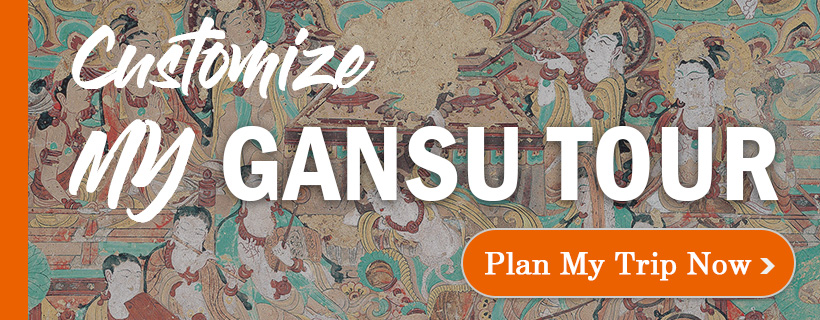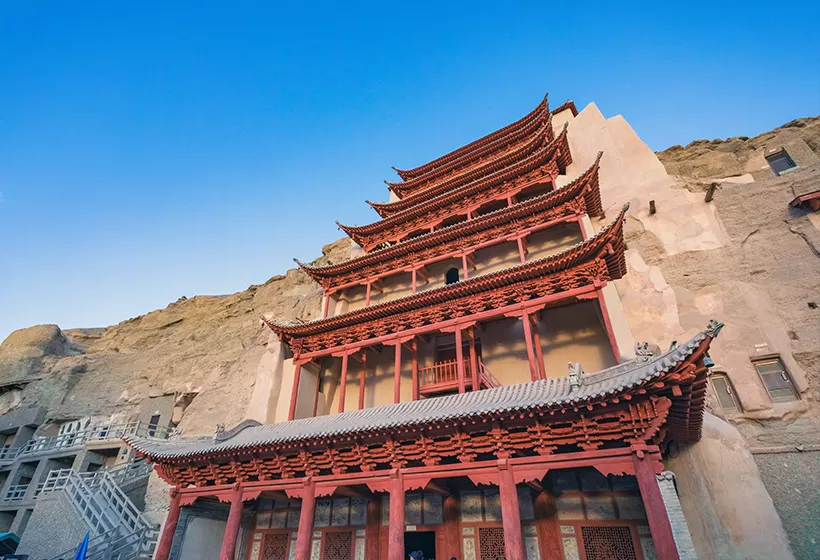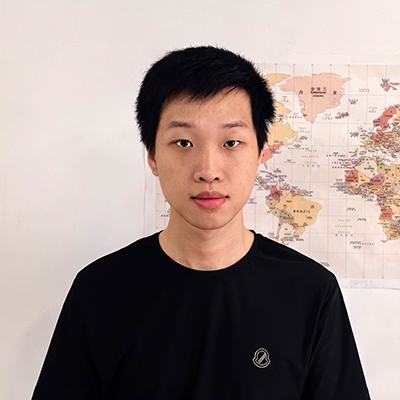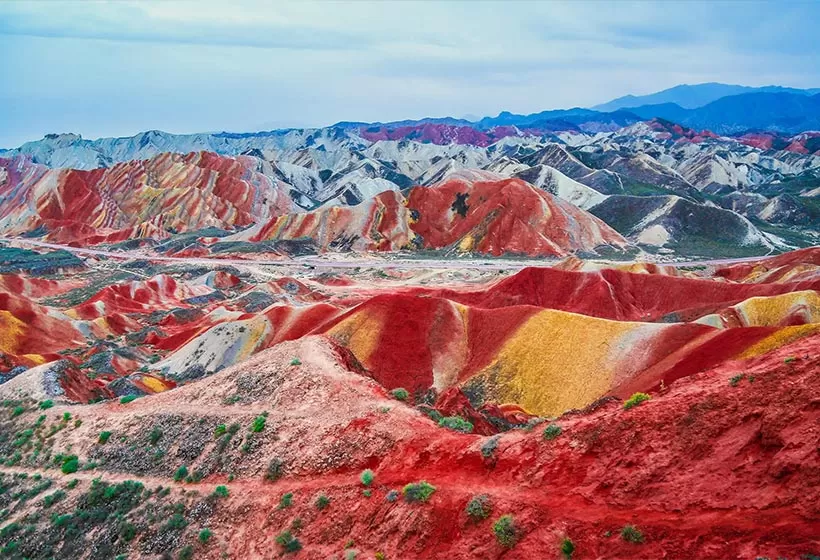Short Introduction to Dunhuang Local Culture: History, Custom, Diet, Festival, etc.
Dunhuang culture, represented by the Buddhist art of the Mogao Caves and the artifacts from the Library Cave, has spanned nearly 2,000 years. It is a brilliant fusion of Chinese culture with influences from Indian, Greek, and Persian cultures, making it a unique gem in the stream of world civilizations.
Brief History
Around 4,000 years ago, according to the Book of Documents, Shun exiled the Sanmiao tribe to the Sanwei, marking the first residents in Dunhuang's history. During the Spring and Autumn period, the Yuezhi and Wusun nomadic tribes grazed their herds in the area.
At the turn of the Qin and Han dynasties, the Xiongnu rose to power and occupied Dunhuang, which was later incorporated into the Han Empire during Emperor Wu of Han's campaigns against the Xiongnu. Zhang Qian's mission to the Western Regions opened up the Silk Road, and in 111 BC, Dunhuang County was established.
During the Tang Dynasty in 622 AD, it was renamed West Shazhou, later changing to Shazhou. In 640 AD, Emperor Taizong of Tang eliminated the obstacles posed by the Western Turks, ensuring smooth trade along the Silk Road, leading Dunhuang into a period of prosperity.
In 781, Shazhou fell under the control of the Tubo Empire. During the 67 years of Tubo rule, economic and cultural flourished, giving appearance to splendid Tibetan Buddhist art in the Mogao Caves. In 848, Zhang Yichao led a rebellion to overthrow the Tubo nobility, establishing the regime of Guiyi Circuit. From the Song to the Qing Dynasty's Yongzheng period, it continued to be known as Shazhou.
In 1528, the Ming government closed the Jiayuguan Pass, leading to a 200-year period of decline for Shazhou. In 1715, Qing troops recaptured the entire Hexi Corridor, and in 1760, it was renamed Dunhuang County.
Dunhuang was liberated on September 28, 1949. On September 28, 1987, Dunhuang County was abolished and Dunhuang City was established.
Culture Core
Dunhuang’s cultural heritage is remarkably extensive, encompassing architecture, painted sculptures, murals painting, and Buddhist culture. The world-renowned Mogao Caves stand as a hallmark of Dunhuang’s architectural stone-carving artistry and the city’s most iconic symbol. These caves, carved over 1,600 years ago, were inscribed as a UNESCO World Heritage Site in 1987.
The murals of Dunhuang contain numerous architectural depictions spanning from the Sixteen Kingdoms period to the Tang and Song dynasties. Though some structures are incomplete, each era is represented, and many murals showcase detailed architectural compositions that reflect the distinct layout styles of different periods.
Dunhuang's painted sculptures, centered around the Mogao Caves, form a major segment of the region's Buddhist artwork. Their expressive postures, detailed lines, lifelike proportions, and vivid expressions bring an intense sense of vitality to these figures, highlights the sculptures' profound artistic and aesthetic value.
The primary figures depicted in Dunhuang’s painted sculptures are various forms of the Buddha, followed by bodhisattvas, illustrating Buddhism’s profound cultural roots. As Buddhism integrated into Chinese culture, these figures transformed into Chinese styles, showing a fusion of foreign Buddhist art with native Chinese elements.
The mural art of Dunhuang merges past and present influences, absorbing both Eastern and Western artistic traditions to create distinct and vibrant imagery that holds a significant place in the annals of Chinese and world art history.
Folk Custom
Since ancient times, Dunhuang has been home to multiple ethnic groups who have thrived together, cultivating a rich tapestry of customs and vibrant folk traditions.
Dunhuang Shehuo, a traditional folk dance performed mainly during the Lunar New Year, is one of the most celebrated and lively displays of folk culture in the region. When performed, drums and gongs resound through the streets, with a large procession of over a hundred performers filling entire avenues with colorful banners and rhythmic displays.
On the evening of the Mid-Autumn Festival, families in Dunhuang gather in their courtyards, place tables and stools at the center. Watermelon, cut into zig-zag patterns, along with mooncakes and guokui (a kind of crispy flatbreads), is arranged neatly on an offering table. After lighting three incense sticks and bowing to the moon, the moon-gazing festivities commence.
For the Winter Solstice, Dunhuang households, regardless of size, prepare a traditional meal known as “Winter Solstice Meal”. It’s customary to eat this meal in the morning to symbolize the gradual lengthening of daylight hours, allowing for more work in the fields, with the hope of a bountiful harvest and prosperous livestock in the coming year.
Special Festivals
The Dunhuang "April 8th Temple Fair" is a traditional folk festival. Every year on the eighth day of the fourth lunar month, local residents, especially Buddhist devotees, gather at Mogao Caves, Sanwei Mountain, and Leiyin Temple for pilgrimage and ancestral worship.
On June 1st each year, Dunhuang hosts a large-scale Sand Sliding Festival. When hundreds of sand-sliding enthusiasts simultaneously slide down the slopes of the dunes, the entire mountain emits a thunderous roar that can be heard clearly even five kilometers away in the city.
Every year on June 6th, people suffering from back and leg pain come to the sand dunes beneath Mingsha Mountain, bury their legs and back in the hot sand while drinking black chicken soup and aged yellow wine, staying under the scorching sun for around three hours to achieve relief from their ailments.
Diet Style
The uniqueness of Dunhuang cuisine lies in its blend of diverse culinary influences from both East and West. As a key hub along the intersections of the west, Dunhuang’s cooking style is primarily local, yet it incorporates elements from various Northwestern ethnic groups as well as Indian and Persian flavors, forming a distinctive culinary tradition.
Daily meals in Dunhuang households, particularly their staple foods, vary based on local ingredients, creating unique customs. The primary staple for Dunhuang residents is various types of bings (flatbread), with nearly thirty different kinds in existence. Among grains, wheat is the most commonly used ingredient, capable of producing a wide range of foods—up to thousands of varieties. One of the most important dishes in Dunhuang’s culinary repertoire is laghman, a hand-pulled noodle dish that holds a special place in their diet.
Dunhuang’s food sources relied on agriculture and animal husbandry, supplemented by well-developed orchards and products from gathering and hunting. Animal husbandry provided meat and dairy products, with hunting being another source of protein. Dunhuang was also renowned as the "land of melons and fruits", with its high-quality produce known as far back as the Han Dynasty. In terms of flavor preferences, Dunhuang people favored sour tastes. Historical records indicate that monasteries made their own vinegar sauces, and there were numerous local workshops dedicated to the production of these condiments.
Cultural Heritage
Dunhuang's cultural heritage encompasses three main aspects: first, the ancient cultural relics of the Dunhuang region, such as the sites of Yang Pass and Yumen Pass, the Xuanquan ruins, and unearthed artifacts from various dynasties like Han bamboo slips; second, the cave complexes represented by the Mogao Caves, including the Western Thousand Buddha Caves and the Yulin Caves; and third, the tens of thousands of artifacts unearthed from the Dunhuang Library Cave. Even on a global scale, this collection of cultural heritage is a unique treasure.
In addition, many forms of Dunhuang art have been included in the "Intangible Cultural Heritage" list, giving rise to numerous outstanding traditional arts such as Dunhuang Clay Sculpture, Dunhuang Dance, and Dunhuang Quzi Opera. Dunhuang, with its uniquely romantic regional characteristics, showcases exquisite cave art, enchanting colored sculptures, captivating ancient music, graceful dance movements, and stunning artworks—all of which serve as a continuous inquiry and exploration of history.
Customize Your Unique Dunhuang Silk Road Trip

If you are interested in one of the Dunhuang itineraries mentioned above, please contact us, and we will be happy to customize it and provide a quote tailored to your preferences.
Alternatively, if you would like to customize your Dunhuang Tour, please visit our Dunhuang Tour Customized Center. We assure you that you will receive a reply within 24 working hours.
Informative Articles for Your Dunhuang Trip
 Ride Camels
Ride Camels- Travel Guide: attractions, weather, hotels, food, etc.
- Top destinations: best places to visit in Dunhuang
- Travel itineraries: itineraries for your reference
- Local culture: brief history, folk culture, festivals, etc.
- Weather: the best time and seasons to visit Dunhuang
- Top attractions: sightseeings to watch in Dunhuang
- Unique perspective: best interesting things to do
- Local food: what to eat while traveling in Dunhuang
- Luxury hotels: best accommodation to stay in Dunhuang
- Dunhuang Tours: customized Dunhuang tours for your reference
GREAT FAMILY CHINA TOUR
JULY 2024 We wanted to thank Grace at China Culture tour for organizing a great tour of China. We enjoyed our Beijing - Xian-Chengdu -Guilin -Yangshuo - Shanghai trip. Our local guides Bruce in Beijing, Susan in Xian, Jane in Chengdu, Mike in Guilin and Mary in Shanghai took care of us…read more details »
Teng Han L from SINGAPORE
Ready to Create a Unique Dream Travel?


